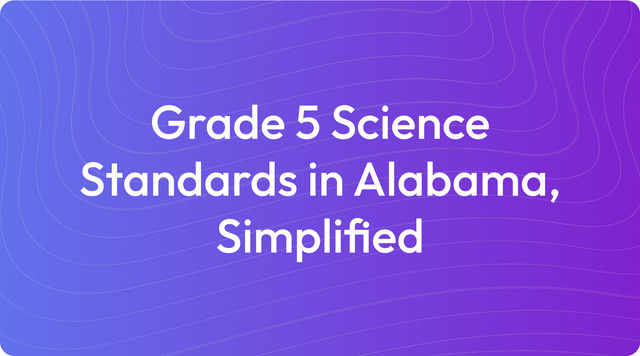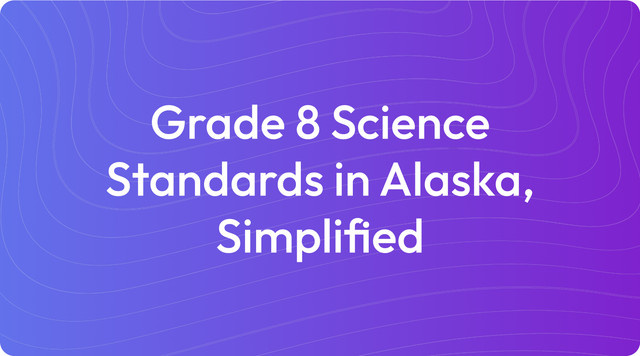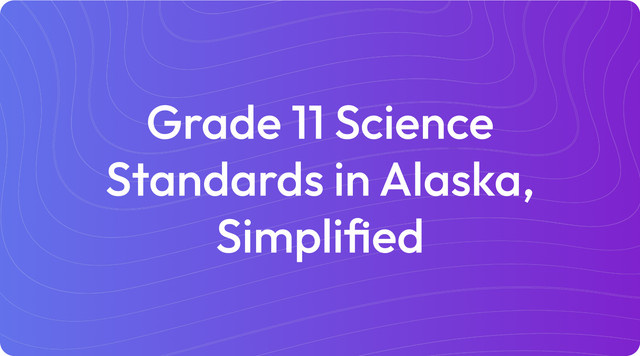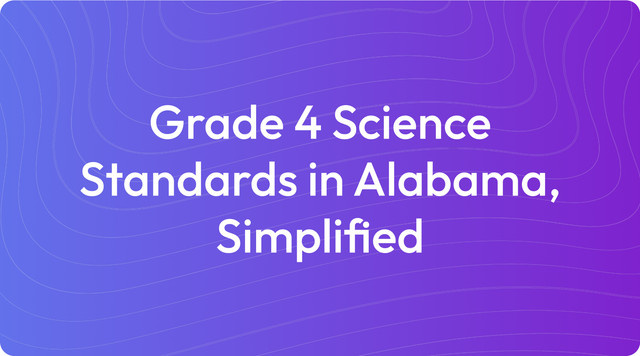Grade 6 Science Standards in Alaska, Simplified
Grade 6 science in Alaska covers energy, cells, heredity, Earth, and engineering. Check out the standards—read more on TeachShare!

We understand that navigating educational standards can be a complex part of your work. Our aim is to offer resources that help you see the connection between these requirements and your daily classroom instruction, making the process more straightforward and manageable.
Education standards are essentially learning goals that outline what students should know and be able to do at each grade level. For teachers, they provide clear benchmarks for student progress without dictating specific teaching methods or curriculum. For instance, the Grade 6 Science Standards in Alaska guide instruction by specifying that students should develop models of molecules (MS-PS1-1) and describe the cycling of matter in an ecosystem (MS-LS2-3), setting clear expectations for learning outcomes.
What Are Grade 6 Science Standards in Alaska?
The Grade 6 Science Standards in Alaska, adapted from the Next Generation Science Standards (NGSS), provide a framework for deeper exploration in key scientific fields. These standards are built around hands-on learning, modeling, and real-world problem-solving to help your students develop critical thinking and inquiry skills. The core standards are organized into the following domains:
- Physical Science (PS): Energy and Matter
- Standard MS-PS1-1: Develop models to describe the atomic composition of simple molecules and extended structures.
- Standard MS-PS1-2: Analyze and interpret data on the properties of substances before and after interactions to determine if a chemical reaction has occurred.
- Standard MS-PS3-5: Construct, use, and present arguments to support the claim that when the kinetic energy of an object changes, energy is transferred to or from the object.
- Life Science (LS): Cells and Ecosystems
- Standard MS-LS1-1: Conduct an investigation to provide evidence that living things are made of cells, either one cell or many different types and numbers of cells.
- Standard MS-LS2-3: Develop a model to describe the cycling of matter and flow of energy among living and nonliving parts of an ecosystem.
- Standard MS-LS1-8: Gather and synthesize information that sensory receptors respond to stimuli by sending messages to the brain for immediate behavior or storage as memories.
- Earth and Space Science (ESS): Earth’s Systems
- Standard MS-ESS1-1: Develop and use a model of the Earth-sun-moon system to describe the cyclic patterns of lunar phases, eclipses, and seasons.
- Standard MS-ESS3-1: Construct a scientific explanation based on evidence for how the uneven distributions of Earth’s resources are the result of past and current geoscience processes.
- Standard MS-ESS2-4: Develop a model to describe the cycling of water through Earth’s systems driven by energy from the sun and the force of gravity.
- Engineering Design (ETS): Problem-Solving
- Standard MS-ETS1-1: Define the criteria and constraints of a design problem with enough precision to ensure a successful solution.
- Standard MS-ETS1-2: Evaluate competing design solutions using a systematic process to determine how well they meet the criteria and constraints of the problem.
- Standard MS-ETS1-4: Develop a model to generate data for iterative testing and modification of a proposed object, tool, or process to optimize the design.
The framework for these standards is guided by the Next Generation Science Standards and the Science Standards for Alaska.
Key Tested Standards
The Alaska Science Assessment, given in grades 5, 8, and 10, focuses on specific performance expectations from the middle school grade band. While not every standard is tested statewide, the key tested standards emphasize foundational concepts in Physical Science, Life Science, Earth and Space Science, and Engineering Design. These standards are designed to assess your students’ ability to analyze, model, investigate, and solve problems through hands-on and real-world applications.
Key Tested Standards for Grade 6 Science in Alaska
1. Physical Science (PS): Energy, Matter, and Reactions
- Standard MS-PS1-1: Develop models to describe the atomic composition of simple molecules and extended structures.
- Why It’s Key: This standard helps students grasp that matter is composed of atoms and molecules, which is a foundational concept for all of chemistry.
- Standard MS-PS1-2: Analyze and interpret data on the properties of substances before and after interactions to determine if a chemical reaction has occurred.
- Why It’s Key: It equips students with the skills to use evidence to tell the difference between physical and chemical changes.
- Standard MS-PS3-5: Construct arguments to support the claim that when the kinetic energy of an object changes, energy is transferred to or from that object.
- Why It’s Key: This introduces the concept of energy transfer, forming a basis for understanding motion and the principles of thermodynamics.
2. Life Science (LS): Cells and Ecosystems
- Standard MS-LS1-1: Conduct an investigation to provide evidence that living things are made of cells, either one cell or many different types of cells.
- Why It’s Key: This standard introduces cells as the fundamental building blocks of all living things, a cornerstone of biology.
- Standard MS-LS2-3: Develop a model to describe the cycling of matter and flow of energy among living and nonliving parts of an ecosystem.
- Why It’s Key: It helps your students see how energy moves and matter is recycled within ecosystems, a critical concept for environmental science.
- Standard MS-LS1-8: Gather and synthesize information that sensory receptors respond to stimuli by sending messages to the brain.
- Why It’s Key: This builds an understanding of how organisms sense and react to their surroundings.
3. Earth and Space Science (ESS): Earth’s Systems and Resources
- Standard MS-ESS1-1: Develop and use a model of the Earth-sun-moon system to describe cyclic patterns such as lunar phases, eclipses, and seasons.
- Why It’s Key: This standard teaches students about our planet's position in the solar system and how its movements result in predictable patterns we can observe.
- Standard MS-ESS2-4: Develop a model to describe the cycling of water through Earth’s systems driven by energy from the sun and gravity.
- Why It’s Key: It helps students appreciate the interconnectedness of Earth’s systems and see how energy from the sun drives major processes like the water cycle.
- Standard MS-ESS3-1: Construct a scientific explanation based on evidence for how the uneven distribution of Earth’s resources is the result of geoscience processes.
- Why It’s Key: This connects geology to the real-world issue of how natural resources like oil, coal, and water are distributed.
4. Engineering Design (ETS): Problem-Solving
- Standard MS-ETS1-1: Define the criteria and constraints of a design problem to ensure a successful solution.
- Why It’s Key: It encourages students to think like engineers by identifying real-world challenges and applying critical thinking to outline potential solutions.
- Standard MS-ETS1-2: Evaluate competing design solutions using a systematic process to determine which best meets the criteria and constraints.
- Why It’s Key: This standard focuses on practical decision-making, teaching students how to systematically test and compare different approaches to find the best solution.
- Standard MS-ETS1-4: Develop a model to generate data for iterative testing and modification of a design.
- Why It’s Key: This introduces the iterative process at the heart of engineering, where designs are continuously tested, modified, and improved.
Why These Standards Are Key for Testing
These standards were selected for assessment because they represent core scientific and engineering skills. They measure your students’ ability to move beyond memorization and actively engage with the material. Here are the key skills assessed:
- Develop and Use Models: Creating models of molecules, food webs, or the water cycle.
- Analyze and Interpret Data: Investigating chemical reactions or observing cell structures under a microscope.
- Explain Phenomena with Evidence: Explaining why seasons occur using an Earth-sun-moon model.
- Solve Real-World Problems: Designing and testing solutions to reduce heat loss or filter water effectively.
The information presented is based on guidance from the Next Generation Science Standards and the Alaska Department of Education & Early Development.
Example Learning Objectives for Unit Planning
Learning objectives are clear, specific statements that describe what students will be able to do by the end of a lesson or unit. They help focus your instruction and give students a clear roadmap for their learning. Using student-friendly “I can” statements makes these goals more accessible and motivating for your class.
To help with your unit planning, here are some example learning objectives for the Grade 6 Science Standards in Alaska, aligned with the key domains:
Physical Science (PS): Energy, Matter, and Reactions
- I can create models to show how atoms combine to form molecules, like water or carbon dioxide.
- I can analyze data to determine if a chemical reaction has occurred by observing color changes, gas production, or heat.
- I can explain how energy is transferred when an object’s motion (kinetic energy) changes, like when a ball rolls down a ramp.
Life Science (LS): Cells and Ecosystems
- I can use a microscope to investigate and provide evidence that all living things are made of cells.
- I can create a model to show how matter cycles and energy flows between plants, animals, decomposers, and the environment.
- I can explain how sensory receptors respond to stimuli and send messages to the brain, like how touch or sight works.
Earth and Space Science (ESS): Earth’s Systems and Resources
- I can create a model of the Earth-sun-moon system to explain patterns like the phases of the moon, eclipses, and seasons.
- I can describe how water moves through Earth’s systems using the water cycle model.
- I can explain how Earth’s natural resources, like oil or minerals, are distributed because of geologic processes.
Engineering Design (ETS): Problem-Solving
- I can identify a problem, like reducing heat loss in a house, and explain what makes a solution successful.
- I can design and test multiple solutions to a problem, like building a water filter, and compare which one works best.
- I can improve my design by testing it, identifying weaknesses, and making changes to make it better.
Sample "I Can" Learning Objectives
- I can describe how molecules are made of atoms and create a model to show their structure.
- I can identify if a chemical reaction has happened by observing changes like bubbles or temperature.
- I can explain how energy moves through an ecosystem using a food web.
- I can use a model to describe why the moon looks different during the month (phases) or how seasons happen.
- I can design and improve a device, like a wind turbine or water filter, to solve a real-world problem.
- I can explain how water moves through the water cycle and connects Earth’s systems.
Key Changes & Updates
The recent updates to the Grade 6 Science Standards in Alaska are designed to foster a more active and practical learning environment. There is a significant shift towards hands-on, inquiry-based learning, encouraging your students to engage directly with scientific concepts through experiments and investigations. A key change is the integration of engineering design principles across the curriculum. This means students will not only learn science content but also apply it by identifying problems, designing solutions, and testing their creations. The standards also place a stronger focus on using models to help students visualize and explain complex phenomena, from the atomic composition of molecules to the Earth-sun-moon system.
In terms of content, the updated standards call for a deeper exploration of core topics like energy transfer, chemical reactions, and the cycling of matter in ecosystems. To make learning more relevant for your students, the framework now explicitly connects scientific principles to Alaska’s unique environment. This includes studying local ecosystems, the distribution of natural resources like oil, and how seasonal changes in Alaska relate to Earth’s systems. The standards also promote real-world problem-solving and the integration of math and literacy skills, asking students to analyze data and construct evidence-based explanations.
Create with TeachShare
We know that aligning your lessons with these updated standards while keeping students engaged is a significant task. Our platform is designed to help you create high-quality, standards-aligned materials quickly, giving you more time to focus on what you do best: teaching. Start creating standards-aligned instructional resources with TeachShare now.
Frequently Asked Questions
What are the main topics covered in Grade 6 Science in Alaska?
Grade 6 science in Alaska is built around four key areas of study:
- Physical Science: This covers the fundamentals of matter, including atomic structure, chemical reactions, energy transfer, and motion.
- Life Science: Students explore cellular structures, the flow of energy through ecosystems, and how sensory systems process information.
- Earth and Space Science: This area focuses on Earth’s interconnected systems (geosphere, biosphere, atmosphere, and hydrosphere), the water cycle, and astronomical patterns like seasons and lunar phases.
- Engineering Design: Students get practical experience identifying problems, designing solutions, testing their creations, and making improvements.
How do the Grade 6 standards connect to Alaska’s environment?
The standards are designed to be highly relevant to students in Alaska by grounding lessons in local context. Here’s how:
- They connect geologic processes to the distribution of Alaska's important natural resources, like oil, minerals, and water.
- Lessons encourage the study of ecosystems unique to the state, such as tundra, forests, and coastal regions.
- Students investigate local phenomena, like the long daylight hours in summer, and learn how they relate to Earth’s tilt and rotation.
- The curriculum challenges students to design solutions for real-world issues, including energy conservation and sustainable resource management.
What are some examples of hands-on activities for Grade 6 Science?
Hands-on learning is a core component of the Grade 6 curriculum. Here are a few examples of activities you can use:
- Physical Science: Students can build models of molecules, such as water and carbon dioxide, to better understand atomic composition.
- Life Science: Activities often include using microscopes to observe plant and animal cells or creating food web models to trace the flow of energy.
- Earth Science: A classic project is creating a model of the water cycle to demonstrate how water moves through Earth's systems.
- Engineering Design: Students can tackle practical problems by designing and testing their own small-scale wind turbines or water filters.
How are students assessed in Grade 6 Science?
Assessment in Grade 6 science focuses on applying knowledge rather than just memorization. Students are typically evaluated through a variety of methods:
- Investigations: They demonstrate understanding by identifying the evidence of a chemical reaction, such as gas production or a color change.
- Models: Students are asked to create models to represent scientific concepts, like the water cycle, food webs, or the Earth-sun-moon system.
- Data Analysis: This involves collecting, graphing, and interpreting data from experiments, such as observing changes in energy during motion.
- Design Projects: Students complete the engineering design process by building, testing, and refining a prototype, like an insulation device.
How can teachers make Grade 6 Science engaging for students?
Keeping students interested is essential for effective learning. Here are some proven strategies for making science class more dynamic:
- Use Real-World Problems: Connect lessons to topics relevant to your students' lives in Alaska, from conserving resources to exploring seasonal changes.
- Incorporate Hands-On Learning: Let students experiment with materials, build models, and test their own designs to learn by doing.
- Use Visuals and Simulations: Supplement instruction with videos, diagrams, and interactive digital tools to help explain complex topics like the water cycle or lunar phases.
- Encourage Collaboration: Have students work in teams to solve problems and test solutions, which fosters communication and teamwork skills.
Answer







